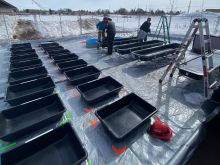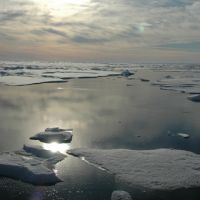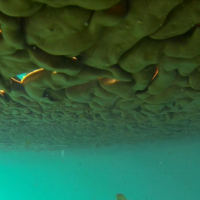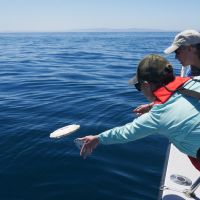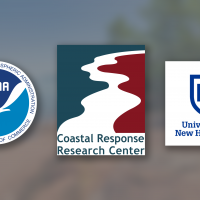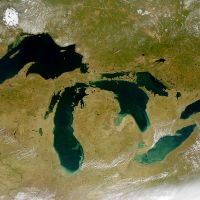NOVEMBER 2, 2020 — OR&R Senior Scientist Lisa DiPinto joined scientists from the EPA and U.S. Coast Guard to conduct experiments at the Ohmsett test tank facility in Leonardo, New Jersey to prepare for larger scale experiments being planned for later this year. Other project scientists from across the nation as well as international participated in the studies remotely via web connections.
Coastal Response Research Center Celebrates 20 Years of Research and Response Partnership with OR&R
The Coastal Response Research Center (CRRC) was established as a partnership between the National Oceanic Atmospheric Administration (NOAA), through the Office of Response and Restoration (OR&R) and the University of New Hampshire (UNH) in 2004.
The CRRC aims to reduce the consequences of spills and other hazards that threaten coastal environments and communities by conducting research, developing new response and restoration methods, and transferring technology to practitioners.
The CRRC is currently co-directed by Troy Baker, a regional resource coordinator within OR&R, and Nancy Kinner, Ph.D., a UNH professor emeritus of civil and environmental engineering, and supported by Administrative Manager Kathy Mandsager.
In 2024, the CRRC celebrates its 20th year in partnership with OR&R and UNH. At the resources and images below, learn how the CRRC and NOAA are making progress on seven main topics, and discover past and current research, projects, workshops, and more on the UNH website.
All Hazards Preparedness
For 20 years, OR&R and the CRRC have applied a broad approach to preparing for and responding to natural and human-caused disasters, from hurricanes and major oil spills to the impact of the novel COVID-19 pandemic. Focused on OR&R's needs throughout the incident preparedness cycle, the CRRC’s work addresses contingency planning, exercises and drills, and evaluation of field-based tactics to monitor hazards, clean up the environment, and accelerate community recovery.
Advancing Tools and Technologies to Protect Communities
OR&R harnesses the latest innovations in technology to improve all facets of its preparedness, response, and restoration mission. Through testing and experimentation in open-ocean, field, and lab settings, the CRRC advances the use of technologies like satellites, unmanned aerial remote sensing, and underwater and ocean surface equipment for detecting marine contaminants and monitoring environmental conditions, as well as improves computer models that help predict environmental changes and better protect communities vulnerable to severe weather, spills, and other disasters.
Natural Resource Damage Assessment and Restoration
The CRRC works with OR&R to develop scientific techniques and implement research for pollution assessment in coastal systems, including those with multiple contaminants and environmental stressors. CRRC staff have assisted OR&R on various environmental evaluations, within and outside of the Natural Resource Damage Assessment process, and on spills of national significance, such as the Deepwater Horizon oil spill.
Common Operational Picture During Response and Environmental Data
The CRRC serves as an incubator for developing new technologies and transferring them into practical tools for spill response. The greatest success in action is OR&R’s and the CRRC's development of the Environmental Response Management Application (ERMA®), a web-based mapping application that centralizes data to provide improved decision-making during environmental response, damage assessment, and restoration. First piloted in 2008 for Portsmouth Harbor, New Hampshire, ERMA’s full-scale operation now offers its application for each region of the U.S.
Arctic Challenges
The CRRC investigates issues related to Arctic oil spill response, assessment, and restoration issues through diverse projects, ranging from laboratory- and field-based studies to promoting dialogue with local, state, regional, and international stakeholders on the future of oil spills in Arctic waters. The CRRC and OR&R work together to consider the path forward for oil spill modeling in the Arctic, including researching oil and ice interactions, investigating new and existing technologies for use across different oil and sea ice conditions, and visualization of fate and trajectory model outputs in ice-infested waters.
Human Dimensions of Incident Response and Pollution
Throughout its partnership, the CRRC has helped NOAA address short- and long-term risks of environmental disasters to human resources, human health, and coastal economies. The CRRC helps design and solidify information pathways so that the most accurate scientific information is accessible and communicated promptly to coastal stakeholders in the event of an incident.
Next Generation of Environmental Engineers and Scientists
The CRRC helps students of all backgrounds pursue STEM careers within NOAA and the fields of preparedness, response, assessment, and restoration. Since its inception, the CRRC has supported eight masters and three Ph.D. students at UNH and placed more than 25 environmental engineering undergraduates with NOAA research projects. In 2021, the CRRC launched a program engaging students from the University of Puerto Rico, Mayagüez Campus in its research, with plans to expand to Historically Black Colleges and Universities and underserved communities in the Northeast U.S.
Articles
Although the Arctic may have "ice-free" summers, it will remain a difficult place to respond to oil spills. With these challenging circumstances in mind, our office again will be sending spatial data specialists aboard the Coast Guard icebreaker Healy for an Arctic Technology Evaluation, a month-long scientific expedition to the Arctic Ocean to demonstrate and evaluate oil spill tools, technologies, and techniques.
NOAA's Office of Response and Restoration co-hosted a workshop in Edmonton, Canada with the goal of bringing together representatives from the U.S. and Canada to examine the potential for incorporating Canadian data into NOAA's online mapping tool, Arctic ERMA®. Learn more about efforts to protect shared natural resources from the escalating risk of environmental accidents in the Arctic.
Research Profiles
In 2019 a two-day workshop on coordinating advances in estimating and measuring oil slick thickness was held in partnership with NOAA Office of Response and Restoration, the Bureau of Safety and Environmental Enforcement (BSEE), with funding from Canada Oceans Protection Plan’s Multi-Partner Oil Spill Research Initiative, and hosted by the Coastal Response Research Center, University of New Hampshire.
Autonomous underwater vehicles (AUVs) present exciting opportunities to measure the extent and type of oil in the water column, especially at deeper depths, during oil spills.
Researchers customized a propeller-driven Remote Environmental Monitoring UnitS (REMUS), specifically a REMUS-600, with a suite of oil sensing tools. These included standard fluorometer and water quality sensors, as well as an innovative holographic camera and water samplers.
Learn more about Coastal Response Research Center Celebrates 20 Years of Research and Response Partnership with OR&R
Cleaning up an oil spill and restoring the environment boils down to the science. Scientists, data managers, and emergency responders from OR&R, the Coastal Response Research Center (CRRC) at the University of New Hampshire, U.S. Coast Guard, University of Michigan, Coastal Monitoring Associates, Water Mapping, Environmental Protection Agency, State of California, and the U.S. Navy partnered to advance oil spill science using the natural oil seeps off the coast of Santa Barbara as their ‘lab’.
The Great Lakes region stands as a crucial ecosystem, supporting diverse species, habitats, and communities integral to both environmental health and human livelihoods.
 An official website of the United States government.
An official website of the United States government. 




